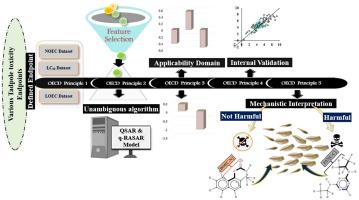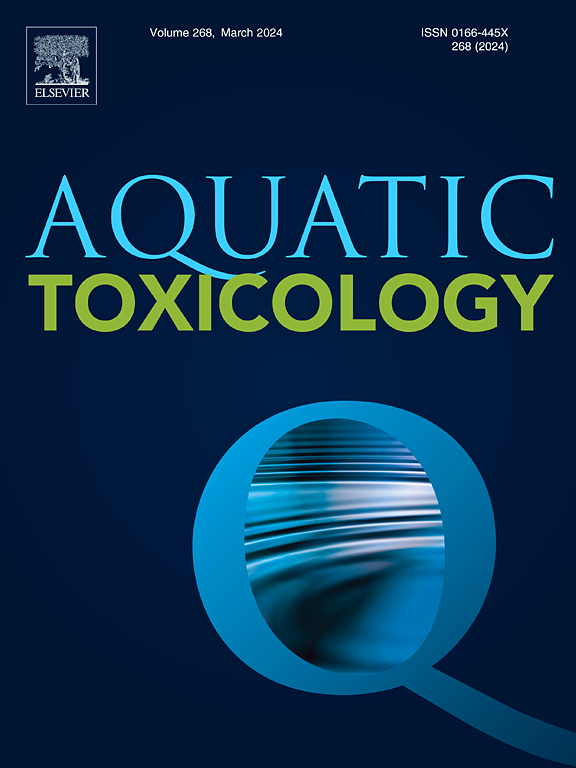利用 QSTR 和 q-RASAR 方法阐明蝌蚪毒性的分子机制。
IF 4.1
2区 环境科学与生态学
Q1 MARINE & FRESHWATER BIOLOGY
引用次数: 0
摘要
蝌蚪作为青蛙的早期发育阶段,是生态系统中暴露于工业和径流源有害有机化合物的毒性和环境健康的重要指标。对每种化合物进行单独评估具有挑战性,因此有必要使用定量结构毒性关系(QSTR)和定量结构活性关系(q-RASAR)等硅方法。我们利用美国环保署的 ECOTOX 综合数据库(其中包括急性半数致死浓度毒性和慢性终点),提取了研究类型、暴露途径和化学品类别等关键数据。根据该数据集开发了基于回归的 QSTR 和 q-RASAR 模型,其中强调了关键的化学描述因子。亲油性和不饱和度对预测急性毒性非常重要,而亲电性、亲核性和分子分支对预测慢性毒性至关重要。此外,还采用了与 "智能共识 "算法相结合的 q-RASAR 模型来提高预测的准确性。这些模型的性能在各种方法之间进行了严格比较。这些完善的模型不仅能预测未测试化合物的毒性,还能揭示潜在的结构影响因素。通过与现有文献的比较验证,我们的方法在生态毒理学方面的相关性和稳健性得到了肯定。本文章由计算机程序翻译,如有差异,请以英文原文为准。

Elucidation of molecular mechanisms involved in tadpole toxicity employing QSTR and q-RASAR approach
Tadpoles, as early developmental stages of frogs, are vital indicators of toxicity and environmental health in ecosystems exposed to harmful organic compounds from industrial and runoff sources. Evaluating each compound individually is challenging, necessitating the use of in silico methods like Quantitative Structure Toxicity-Relationship (QSTR) and Quantitative Read-Across Structure-Activity Relationship (q-RASAR). Utilizing the comprehensive US EPA's ECOTOX database, which includes acute LC50 toxicity and chronic endpoints, we extracted crucial data such as study types, exposure routes, and chemical categories. Regression-based QSTR and q-RASAR models were developed from this dataset, emphasizing key chemical descriptors. Lipophilicity and unsaturation were significant for predicting acute toxicity, while electrophilicity, nucleophilicity, and molecular branching were crucial for chronic toxicity predictions. Additionally, q-RASAR models integrated with the "intelligent consensus" algorithm were employed to enhance predictive accuracy. The performance of these models was rigorously compared across various approaches. These refined models not only predict the toxicity of untested compounds but also reveal underlying structural influences. Validation through comparison with existing literature affirmed the relevance and robustness of our approach in ecotoxicology.
求助全文
通过发布文献求助,成功后即可免费获取论文全文。
去求助
来源期刊

Aquatic Toxicology
环境科学-毒理学
CiteScore
7.10
自引率
4.40%
发文量
250
审稿时长
56 days
期刊介绍:
Aquatic Toxicology publishes significant contributions that increase the understanding of the impact of harmful substances (including natural and synthetic chemicals) on aquatic organisms and ecosystems.
Aquatic Toxicology considers both laboratory and field studies with a focus on marine/ freshwater environments. We strive to attract high quality original scientific papers, critical reviews and expert opinion papers in the following areas: Effects of harmful substances on molecular, cellular, sub-organismal, organismal, population, community, and ecosystem level; Toxic Mechanisms; Genetic disturbances, transgenerational effects, behavioral and adaptive responses; Impacts of harmful substances on structure, function of and services provided by aquatic ecosystems; Mixture toxicity assessment; Statistical approaches to predict exposure to and hazards of contaminants
The journal also considers manuscripts in other areas, such as the development of innovative concepts, approaches, and methodologies, which promote the wider application of toxicological datasets to the protection of aquatic environments and inform ecological risk assessments and decision making by relevant authorities.
 求助内容:
求助内容: 应助结果提醒方式:
应助结果提醒方式:


